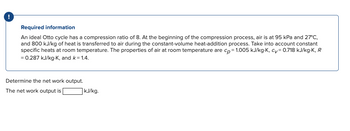
Elements Of Electromagnetics
7th Edition
ISBN: 9780190698614
Author: Sadiku, Matthew N. O.
Publisher: Oxford University Press
expand_more
expand_more
format_list_bulleted
Question
thumb_up100%

Transcribed Image Text:Required information
An ideal Otto cycle has a compression ratio of 8. At the beginning of the compression process, air is at 95 kPa and 27°C,
and 800 kJ/kg of heat is transferred to air during the constant-volume heat-addition process. Take into account constant
specific heats at room temperature. The properties of air at room temperature are cp = 1.005 kJ/kg-K, cv=0.718 kJ/kg-K, R
= 0.287 kJ/kg-K, and k = 1.4.
Determine the net work output.
The net work output is
kJ/kg.
Expert Solution
This question has been solved!
Explore an expertly crafted, step-by-step solution for a thorough understanding of key concepts.
Step by stepSolved in 3 steps with 6 images

Knowledge Booster
Learn more about
Need a deep-dive on the concept behind this application? Look no further. Learn more about this topic, mechanical-engineering and related others by exploring similar questions and additional content below.Similar questions
- Q3: What is the ideal Otto-cycle efficiency for a 8:1 compression ratio, and how does it compare to the Carnot efficiency for a flame temperature of 3000K?arrow_forwardyale L 15 A gas power cycle uses air as the working fluid and has two turbine sections as shown in the figare below. The power produced by Turbine I is used to drive the compressor, and Turbine 2 produces output power W. Air enters the compressor with a semperature of 290 K and a mass flow rate of -2 (kgs] (State I); the air exits the compressor at 44SK (State 2). Heat is transferred from a high- temperature thermal reservoir, Ta- 1400 [K), to Heat Exchanger 1 at a rate Q,- The lemperature of the air is raised to 1100 [K] (State 3) as it flows through Heat Exchanger 1. The air enters Turbine I where it is expanded to State 4. The flow then proceeds to Turbine 2 and exits with a temperature of 500 (K] (State 5). Heat is then removed from the air through Heat Exchanger 2 at a rate Q which is rejectod to the low-temperature thermal reservoir, TL-200 (K). (A) Determine the temperature at the inlet to Turbine 2, Te (b) Calculate the power output from Turbine 2, W. (e) Calculate the rate of…arrow_forwardHello Sir,Good Night.I have a question in my homework related thermodynamics lesson.The following below is my question. Please advice, thank youarrow_forward
arrow_back_ios
arrow_forward_ios
Recommended textbooks for you
 Elements Of ElectromagneticsMechanical EngineeringISBN:9780190698614Author:Sadiku, Matthew N. O.Publisher:Oxford University Press
Elements Of ElectromagneticsMechanical EngineeringISBN:9780190698614Author:Sadiku, Matthew N. O.Publisher:Oxford University Press Mechanics of Materials (10th Edition)Mechanical EngineeringISBN:9780134319650Author:Russell C. HibbelerPublisher:PEARSON
Mechanics of Materials (10th Edition)Mechanical EngineeringISBN:9780134319650Author:Russell C. HibbelerPublisher:PEARSON Thermodynamics: An Engineering ApproachMechanical EngineeringISBN:9781259822674Author:Yunus A. Cengel Dr., Michael A. BolesPublisher:McGraw-Hill Education
Thermodynamics: An Engineering ApproachMechanical EngineeringISBN:9781259822674Author:Yunus A. Cengel Dr., Michael A. BolesPublisher:McGraw-Hill Education Control Systems EngineeringMechanical EngineeringISBN:9781118170519Author:Norman S. NisePublisher:WILEY
Control Systems EngineeringMechanical EngineeringISBN:9781118170519Author:Norman S. NisePublisher:WILEY Mechanics of Materials (MindTap Course List)Mechanical EngineeringISBN:9781337093347Author:Barry J. Goodno, James M. GerePublisher:Cengage Learning
Mechanics of Materials (MindTap Course List)Mechanical EngineeringISBN:9781337093347Author:Barry J. Goodno, James M. GerePublisher:Cengage Learning Engineering Mechanics: StaticsMechanical EngineeringISBN:9781118807330Author:James L. Meriam, L. G. Kraige, J. N. BoltonPublisher:WILEY
Engineering Mechanics: StaticsMechanical EngineeringISBN:9781118807330Author:James L. Meriam, L. G. Kraige, J. N. BoltonPublisher:WILEY

Elements Of Electromagnetics
Mechanical Engineering
ISBN:9780190698614
Author:Sadiku, Matthew N. O.
Publisher:Oxford University Press

Mechanics of Materials (10th Edition)
Mechanical Engineering
ISBN:9780134319650
Author:Russell C. Hibbeler
Publisher:PEARSON

Thermodynamics: An Engineering Approach
Mechanical Engineering
ISBN:9781259822674
Author:Yunus A. Cengel Dr., Michael A. Boles
Publisher:McGraw-Hill Education

Control Systems Engineering
Mechanical Engineering
ISBN:9781118170519
Author:Norman S. Nise
Publisher:WILEY

Mechanics of Materials (MindTap Course List)
Mechanical Engineering
ISBN:9781337093347
Author:Barry J. Goodno, James M. Gere
Publisher:Cengage Learning

Engineering Mechanics: Statics
Mechanical Engineering
ISBN:9781118807330
Author:James L. Meriam, L. G. Kraige, J. N. Bolton
Publisher:WILEY